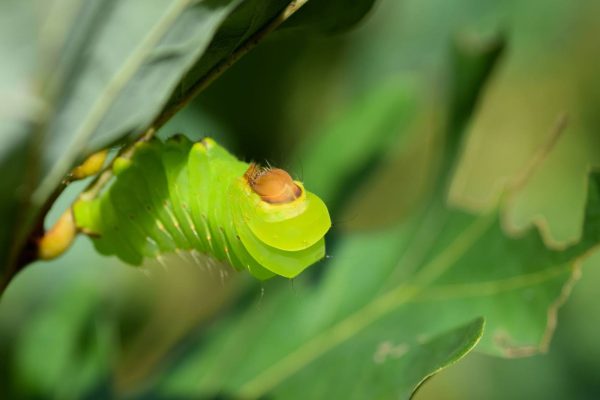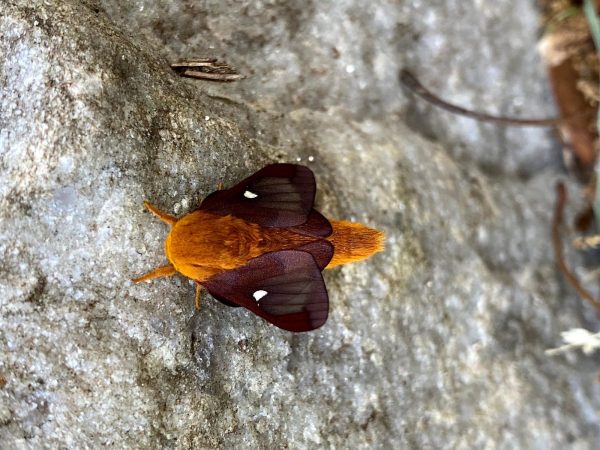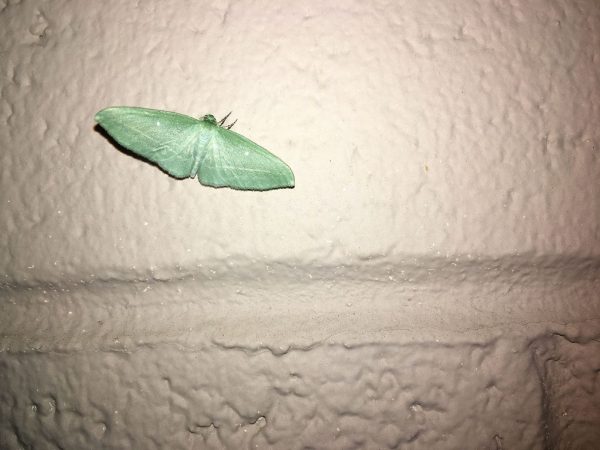Polyphemus Moth (Antheraea polyphemus).
Moths are one of the many forgotten but ever-important insect groups that we have. Their more apparent and charismatic kin, the butterflies, seem to garner somewhat lopsided attention and appreciation, as do bees, ladybugs, lightning bugs, and praying mantises. Many of our moths aren’t particularly eye-catching, and most are active at night. Regardless of what contributes to them being overlooked, this group of insects is ecologically important and deserves some time in the spotlight. I’m not the only one who feels this way, as the week of July 20-28 has been designated National Moth Week. What better time to provide a quick introduction to these cryptic but truly remarkable insects?
About Moths
Moths, along with butterflies, comprise the Order Lepidoptera. This is a very diverse group of insects, with there being approximately 17,500 species of butterflies, and a whopping 160,000 species of moths, nearly 11,000 of which occur in the United States. Immediately appreciable is just how much moths contribute to biodiversity.

Distinguishing between moths and butterflies isn’t always straightforward, but paying attention to their antennae usually helps. Butterflies tend to have narrow antennae that are clubbed at the end, whereas moths typically have feathery or overall more elaborately structured antennae. As mentioned, they also differ in the time of day that they’re active, with most moths being nocturnal (active at night), and butterflies being mostly diurnal (active during the day). Both groups start out as caterpillars and then go through a period of dormancy (within a cocoon for moths and within a chrysalis for butterflies) and eventually emerge as winged adults.
Helpful Nighttime Creatures
What’s interesting is that despite differing in their time of activity, moths and butterflies do many of the same things. Their mouthparts are designed for consuming nectar, so while butterflies flutter to find nectar resources during the day, moths do the same, just at night. And the same way that butterflies aid in the pollination of the various plants that they visit, moths do too, just at a time when butterflies, bees, and other pollinators are inactive. Essentially, moths take care of pollination duties while the swallowtails and bumblebees of the world get their well deserved beauty sleep.

Beyond their importance as nighttime pollinators, moths make up an integral part of local food webs. With there being so many species of moths, there are so many things that eat them, especially during the caterpillar stage. Birds in particular rely on an abundance of caterpillars during the breeding season. It’s been estimated that a Black-capped Chickadee needs between 6,000 to 9,000 caterpillars to rear one brood of chicks! Of course, butterfly caterpillars make up a percentage of that several thousand, but given the sheer number of moth species, moth caterpillars likely contribute greatly to that haul.

Furthermore, it isn’t just the larvae of moths that keep local food webs intact. Adult moths are frequently consumed by another under-appreciated group of flying animals: bats. While there are far fewer bats on our landscape these days due to the frightening spread of white-nose syndrome, moths still share the air with our furry flyers and serve as a primary food source for several local bat species. Amphibians, mammals, other insects, and even owls feed on moths as well.

The Challenges of Moths
Despite their abundance and diversity, moth populations face several challenges. The destruction of wild spaces eliminates large swaths of plants that their larvae need in order to survive. Even when disturbed areas are allowed to reestablish, often what grows back is an assortment of invasive species, which does little to support moths who are fine tuned to seek out the plants that they evolved alongside. The indiscriminate use of pesticides is another factor believed to be contributing to the decline of moths and other insects for that matter. And of course, the effects of light pollution is another big concern.
How Can we Help?
The question then is how can we aid in the recovery of this important group of insects? It just so happens that there are a number of ways that we can help:
- Add native plants to your property! Moths need an abundance of native flowering plants to visit for nectar, and their larvae need the host plants that they’ve evolved to consume. Remember that plants have chemical defenses to combat the browsing of various organisms but, over evolutionary time, consumers develop ways to combat those defenses. Many insect species are only equipped to circumvent the defenses of a handful of plant species (i.e. the species that their ancestors managed to figure out). Some plant Genera though, and trees in particular, have been found to be attractive to a great variety of caterpillar species. Oaks, cherries, and willows all rank really high for supporting caterpillar diversity.
- Beneath the host plants that you install, consider providing caterpillars with “soft landings.” After caterpillars finish their feeding frenzies, many drop to the ground from their host plant in order to spin a cocoon within the leaf litter, while others burrow underground to do the same. Having smaller ground cover, plants can provide falling caterpillars with safe places to land and stable microclimates to exist within during this critical life stage. Adding a diversity of native herbaceous plants beneath a host tree or shrub provides cover for cocooning caterpillars, as will choosing NOT to rake fallen leaves and other fallen plant material.
- Turn off outdoor lighting, or switch to insect friendly bulbs. As you’re probably aware, many insects are drawn to light fixtures once the sun goes down. This can harm insects in a variety of ways, including various forms of physiological dysfunction, exhaustion, and even incineration. Research has found that yellow LED lights attract fewer insects, and consequently, switching to that bulb type will go a long way toward being less harmful to local moth populations. Also, ensuring that your lights don’t run from sunup to sundown helps as well. Leaving lights (with yellow LED bulbs) on a motion sensor mode can decrease the amount of time that they run but still provide the security benefits. No matter the case, less light is better.
- Use iNaturalist to document species that visit your property! iNaturalist is a community science application that aids in identifying species from photographs. All you do is take a photo, and the application will provide suggestions as to which species it is that you’re looking at. Other experts in the field will then either confirm or deny the identification. That data then goes to scientists conducting research on those species. With so many moth species to keep track of, an application like iNaturalist goes a long way in assisting in their documentation!
- Along the same lines, consider participating in National Moth Week! National Moth Week is a community science based project where moth enthusiasts set up stations to observe what species occur in their area. The data acquired at those stations is in turn used by moth ecologists who study the distribution and ecology of those species. This occurs every year in the last full week of July and it’s free to register. Find more information on the project here: https://nationalmothweek.org/about/

Final Thoughts
I hope you enjoyed reading this article. Moths are pretty amazing insects, and I wish more folks knew this to be true. Summer provides a wealth of opportunities to appreciate moth diversity. I hope you feel inclined to seek some out yourself.
Thank you for reading.
Sebastian Harris, Conservation Easement Steward
